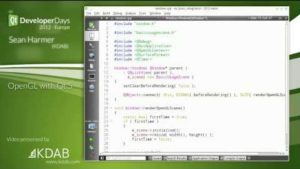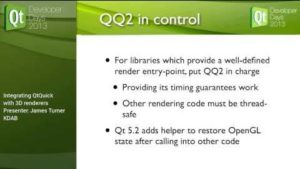Abstract: Qt5 introduces better support for OpenGL from the QPA/Lighthouse abstraction, through a new set of OpenGL classes up to QtQuick 2 and Qt3D. OpenGL is also very often used for games and as the central content widget in desktop applications. With the advent of QtQuick 2 it is now easy to write entire user […]
OpenGL Get the RSS Feed
Modern Shader-based OpenGL Techniques
Abstract: Modern OpenGL abandons the old fixed-function pipeline in exchange for a programmable pipeline using shaders and buffer objects. This offers much more flexibility to developers and opens the door to a huge range of effects and techniques whilst at the same time making available huge performance improvements. This presentation will teach you about the […]
Integrating QtQuick 2 with 3D renderers
Abstract: “QtQuick in Qt5 uses OpenGL to deliver fluid, performant visuals, and an internal scene-graph structure to permit threaded rendering, decoupling the main application thread from interacting directly with the graphics driver. For developers work with an existing rendering or visualisation technology, this presents both an opportunity but also problems; QtQuick offers a compelling, modern […]
KDAB joins Khronos and welcomes Vulkan for next generation graphics
We are proud to announce that KDAB is now a contributor member of the Khronos Group, a not for profit, member-funded consortium focused on the creation of royalty-free open standards for parallel computing, graphics and dynamic media on a wide variety of platforms and devices. As a contributor member of the Khronos Group, KDAB is […]
Qt3D 2.0 The FrameGraph
Continuing our blog post series about the rewrite of Qt3D. Introduction For quite some time now, you’ve been hearing about Qt3D’s Framegraph. Although a brief definition of what the Framegraph is was given in the previous articles, this blog post will cover it in more detail. After reading this post, you will understand the difference […]
Fun with Android
AKA: I know what you did last Christmas ! Hello folks, I’d like to share with you a few things that I did during this Xmas. Besides the fact I’ll never ever take a vacation before Xmas, because Brasov is a tourist attraction and it was FULL of tourists in that period. I could ski […]
Shadow Mapping in Qt3D 2.0
Continuing our blog post series about the rewrite of Qt3D. One of the biggest driving factors behind the design of Qt3D 2.0 is the ability to configure the renderer in order to accommodate custom rendering techniques. In this blog post I will explain how to render a scene in Qt3D with shadows.
Overview of Qt3D 2.0 – Part 2
An Example of Rendering with Qt3D In the previous article we learned about the requirements and high-level architecture of Qt3D 2.0. In order to put some of this into context and to give you a concrete example of how it looks to draw something in Qt3D using the QML API, we will now briefly show […]
Overview of Qt 3D 2.0 – Part 1
by Sean Harmer of KDAB Back in the days when Qt was owned by Nokia, a development team in Brisbane had the idea of making it easy to incorporate 3D content into Qt applications. This happened around the time of the introduction of the QML language and technology stack, and so it was only natural […]
Overview of Qt3D 2.0 – Part 1
Introduction Back in the days when Qt was owned by Nokia, a development team in Brisbane had the idea of making it easy to incorporate 3D content into Qt applications. This happened around the time of the introduction of the QML language and technology stack, and so it was only natural that Qt3D should also […]


